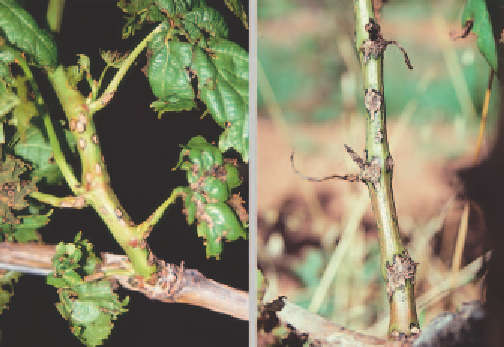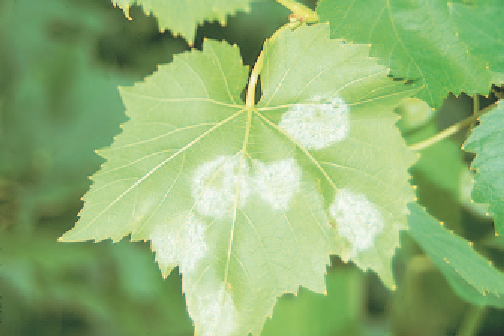Agriculture Reference
In-Depth Information
Symptoms
The pathogen attacks all green parts of the vine,
particularly the leaves.
Downy mildew first appears on leaves as small, pale yellow
spots termed 'oilspots', best seen on the upper surfaces
of leaves. When young, the spots are surrounded by a
chocolate halo. On young foliage, the spots grow rapidly
to 50 mm in diameter and may merge to cover most of the
leaf. During warm, humid weather, white downy growth
(spores) develops on the undersides of the oilspots. As the
disease progresses or during hot, dry weather, the centres
of the spots dry out and become brown, leaving an outer
ring of yellow containing active downy mildew.
On mature leaves, in late summer and autumn, infection
is confined by the veins and forms a patchwork of small,
angular, yellow-brown spots. Severely affected vines may
be defoliated.
Oily brown areas may develop on infected shoots, stems
and tendrils.
Fig 9.13 Black spot symptoms on cane (left) and overwintering in
cankers (right).
Source of infection and spread
The fungus survives for several years in cankers on
permanent wood on the vine (e.g. on cordons and spurs), and
on prunings. During cool, wet conditions in spring, cankers
produce spores, which are dispersed by water splash or insects
onto leaves and shoots. Only young, actively growing tissue is
susceptible and foliage must remain wet for several hours for
infection to occur. The disease is favoured by cool, wet
weather while hot, dry conditions inhibit the disease.
Importance
Sultana and some table grape varieties are the most
susceptible to black spot. It rarely affects commercial wine
varieties and the disease is uncommon in well-managed
vineyards. It is most likely to be serious in poorly managed
plantings following a series of wet springs that allowed the
build-up of inoculum.
Fig 9.14 Young oil spot caused by downy mildew.
Management
•
Use controls only in susceptible varieties during wet
springs.
Remove and destroy infected canes and spurs to reduce
sources of overwintering fungal inoculum.
•
In wet seasons, apply pre-infection (protectant) fungicides
to young growth from budburst onwards. Usually only one
to two sprays will be required to keep leaves and foliage
free from disease until age-related (ontogenic) resistance
develops in the canopy, eight to 10 weeks from budburst.
•
DOWNY MILDEW
■
Cause
The oomycete
Plasmopara viticola
.
Fig 9.15 Downy mildew showing the white down (spores) that
develops beneath the oil spots after a suitable, warm humid night.














